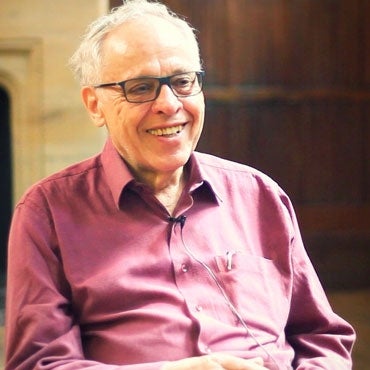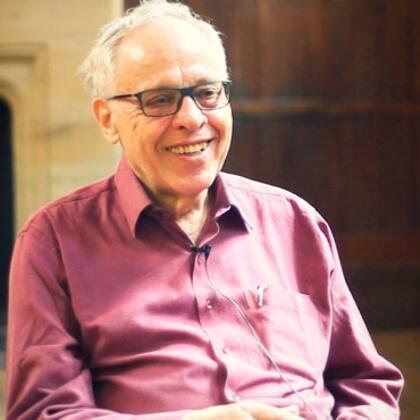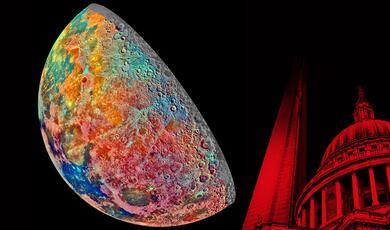Observing the Dark Ages
Share
- Details
- Transcript
- Audio
- Downloads
- Extra Reading
Long before there were stars, there was the stuff that stars are made of. This era of the universe is called the dark ages, when the universe was transparent before the galaxies formed. Peering back in time with the largest telescopes reveals younger and younger galaxies ad the time when there were no galaxies and no stars. For the first 380,000 years of cosmic history, the universe was dense and opaque. All was dark - a dense fog, dominated by an impenetrable mixture of radiation and matter. Looking forward from the Big Bang, the fog lifted as the universe cooled, resulting in a race to detect the state of the universe in the dark ages.
Download Transcript
5 April 2017
Observing the Dark Ages
Professor Joseph Silk
The biggest question in all of scientific enquiry is about human origins: where do we come from? This is a deeper and more profound question than anything that anthropology can answer. Our ultimate origin precedes that of our surroundings. We need to go back in time to long before the earth formed, long before the sun formed, long before our galaxy formed, and even long before the first galaxies in the universe had formed.
Just as with understanding the origins of modern civilization, we need to explore the dark ages. In cosmology, the dark ages occurred within the first million years after the Big Bang, long before any stars or galaxies had formed. There were just vast numbers of hydrogen gas clouds, the raw material and the building blocks from which the galaxies such as our Milky Way eventually emerged.
Nor is this enough. All we see in the visible universe ultimately emerged from an immensely rapid expansion at the beginning of time, the epoch of inflation some trillionth of a trillionth of a trillionth of a trillionth of a second after the Big Bang, so our best theory tells us. We call this theory inflation. According to Stephen Hawking, it’s the best next thing to a free lunch, in that the vast observed universe assembled from almost nothing. But it’s just a theory: we would dearly love to get firm evidence.
Here is how our cosmologists hope to assemble such evidence. The fossil radiation from the Big Bang, the cosmic microwave background or CMB, testifies to the perfect furnace that once prevailed. Discovered by Bell Labs radio astronomers Arno Penzias and Robert Wilson in 1964, it has since been studied with exquisite detail. Tiny fluctuations were detected, initially by George Smoot with NASA’s COBE satellite in 1992, that revealed the seeds from which all structure formed.
Many experiments around the world have refined these measurements, with the current challenge being pursued by US-led experiments high up on the Atacama plateau in Chile and at the South Pole. These are sites where the earth’s atmosphere is sufficiently cold and thin that absorption from water vapour is largely mitigated, thereby allowing astronomical observations far into the microwave band where the cosmic microwave background radiation is most intense. These telescopes, along with earlier balloon and satellite experiments, have confirmed one major prediction of inflation, the distribution of the strengths of the primordial fluctuations.
But this result has not silenced the sceptics: the fluctuation distribution is not a generic prediction of inflation. One hope is that tiny twists in the radiation, seen as a particular type of polarization, are produced by the immense shaking of the universe when it inflated. The imprint of the dark matter clumpiness of the universe has the effect of gravitationally lensing the CMB.
There are two types of polarization that are relevant. One is compressional, the other involves shear or vorticity. In vector language, there is the divergence or E mode and the curl or B mode of the field into which temperature fluctuations can be composed. Gravitational lensing by dark matter of the CMB produces both modes. These are a foreground that must be removed.
An even larger and closer foreground is that of polarization generated by interstellar dust. This too consists of both polarization modes. However gravity waves only produce the shear mode, they don’t compress. So the foregrounds must be removed. This leads in principle to a unique imprint of gravity waves on the CMB.
Inflation generates low frequency gravity waves. The frequency is very low, corresponding to billions of year between wave crests. Gravity waves at kilohertz frequencies were recently detected directly from black holes by the LIGO experiment. The inflationary signal is only detectable indirectly via its imprint on the fluctuations in the cosmic microwave background. Many experiments are being developed now to search for this polarization imprint, which requires an increase of sensitivity by orders of magnitude over the current generation of experiments.
But even this may not be enough. There is no guaranteed result. Most inflation models, as we have learnt from the ESA-launched Planck satellite, are likely to have low intrinsic polarization. This could mean undetectably low gravity wave-induced polarization. How low we don’t know.
Polarisation of the CMB may not be the ultimate answer. Can we do better?
In fact, there is only one prospect for a guaranteed detection of the occurrence of inflation. There is an intrinsic element of randomness in the sky predicted by all inflation models. We call this non-gaussianity. It is present at some level in all cases and embedded in the primordial fluctuations that seeded structure. In principle, non-gaussianity in the primordial universe is detectable. But only if we can achieve the daunting task of cleaning up the foregrounds.
Non-gaussianity should be especially strong for those models favored by the Planck data. However it is incredibly difficult to measure as all foregrounds are non-gaussian and must be removed. It is like driving in a storm with a dirty windshield and trying to glimpse the sky. To detect the effect, we need to improve cosmological precision by a factor of at least 100.
Any measurement is limited by the number of independent modes. Think of these as N patches on the sky. For the microwave background it’s a million. It is no larger because the smaller patches are hopelessly complicated by the physics of structure formation. So the ultimate limit of any microwave background experiment in cosmology is one over the square root of N or 0.1 percent precision. But to trap non-gaussianity, we need to do 100 times better.
Many astronomers are hoping that the next generation of large galaxy surveys will provide more accuracy. The Sloan Digital Sky Survey did wonders with a million redshifts of galaxies. Future surveys, to be performed by the NSF/DOE-funded Large Synoptic Survey telescope in Chile, as well as other projects, will obtain up to a billion redshifts. Of course galaxies are complex systems, so we’ll need to do some averaging. Most optimistically, that could increase N to 108, getting us to a factor of 10 improvement over the cosmic microwave background.
This means we will be able to do cosmology to 0.01 percent precision within a decade. Even that is not enough to tackle the inflationary prediction. Only by increasing the number of elements by another factor of 100 can we hope to do this That means going to the dark ages where there are a million building block clouds for every galaxy! And that means utilizing radio astronomy, by far the best way to map clouds of atomic hydrogen.
The trick is to look at a wavelength of 21 centimeters or a frequency of 1420 MHz. We can see the hydrogen in absorption against the backdrop of the cosmic microwave background radiation. But the search can only be performed in the dark ages, before emission from stars complicated the simplicity of the first clouds. This means going back to a redshift of 50, when the universe was only a few million years old. Thanks to the redshift of the expanding universe, we need to observe at a wavelength of 50 times 21cm, or about 10 meters, or at a frequency of 30 MHz.
Here is how this works. We map hydrogen clouds throughout our Milky Way by a characteristic signal at a wavelength of 21 centimeters, that is produced by the electron in a hydrogen atom flipping its direction of spin, when it gains a tiny amount of energy on being scattered by an incident photon.
The hydrogen in the universe cools down more rapidly than the cosmic blackbody radiation. Since it is cooler than the background, it can absorb photons of precisely the frequency that causes the electron spin to flip. One flip state has slightly more energy than the other. The result is that we detect a dark spot, really what we call a spectral absorption line, at a characteristic wavelength in a background image.
The sweet spot is a redshift of 50, when the universe was a fiftieth of its present size, a few million years after the Big Bang. This is where the absorption signal is largest. In this way, if we had access to these early clouds, we could increase the number of independent patches on the sky to a trillion! In practice, we would observe the clouds statistically, not simply by counting but by looking for their imprint on the scatter in the distribution of absorption patches from point to point on the sky.
The downside is that the observed frequency of this highly redshifted radiation is only 30 MHz. Normally, we do radio astronomy in the GHz band. At much lower frequencies, the earth is a hopelessly noisy site for this type of observation, thanks to mobile phones, internet, television, aiming at detection of a very weak all-sky cosmic signal. The backgrounds from all of this interference render a search for an extremely faint cosmological all-sky signal virtually impossible from anywhere on the Earth.
Our best hope is for a radio array is on the far side of the Moon, the most radio-quiet place in the inner solar system. So far at least, there are no mobile phones on the moon. Very simple antennas are needed, just dipoles roughly a wavelength or 10m across, but many of them. Perhaps a million scattered over the lunar surface, with a very powerful signal correlator on an orbiting satellite to transmit back to earth.
We could then answer the most important question in cosmology, where did we come from, by mapping out the predicted inflationary signal in the sky. It must be present if inflation occurred, and it’s the only signal that is a guaranteed test. The physical beginning of the universe may become observable.
How realistic is an observatory on the moon? The Chinese are there already, at least robotically. In December 2013, the Chang’e mission installed a small telescope. With successive missions, the Chinese Space Agency is planning to develop an unmanned base on the moon, beginning in 2018. Humans will follow, the first woman on the moon being scheduled for 2022.
In the west, NASA has sent men to the Moon, has been there and done that, in the 1970s. Now, NASA is mostly focusing on planning for human exploration of Mars. No doubt the costs of a manned mission to Mars are not realizable in any near-future scenario, but taking the long-term view, this is surely inevitable, following a series of robotic missions that are already being planned.
Meanwhile, ESA is designing a moon village featuring business and tourism, and maybe science. Trips around, and eventually to, the Moon already appear in tourism plans in the private sector. Nor are business ventures being neglected. As for the long term future of manned space exploration, all studies agree that realistically a lunar base must be the first step. But right now, science is an afterthought for a future lunar base.
Such reasoning sells science short. The scientific case for building a radio telescope array on the far side of the moon is more compelling than for any terrestrial or space telescope we could ever envisage within the next century.
© Professor Joseph Silk, 2017
This event was on Wed, 05 Apr 2017
Support Gresham
Gresham College has offered an outstanding education to the public free of charge for over 400 years. Today, Gresham plays an important role in fostering a love of learning and a greater understanding of ourselves and the world around us. Your donation will help to widen our reach and to broaden our audience, allowing more people to benefit from a high-quality education from some of the brightest minds.


 Login
Login







